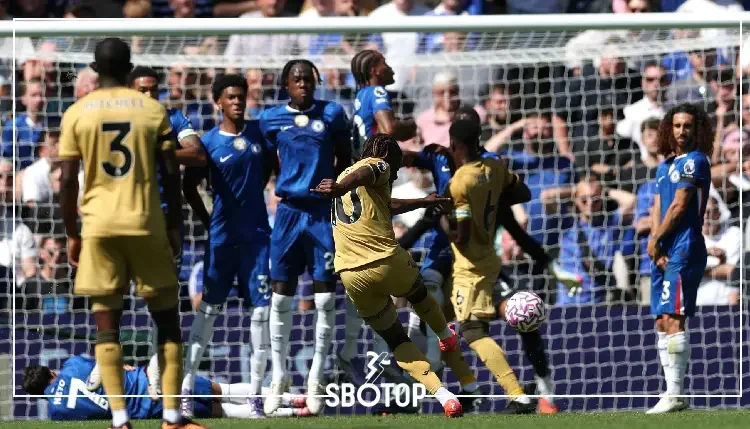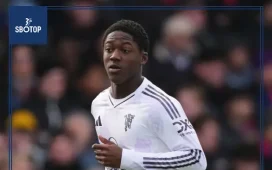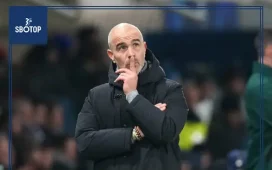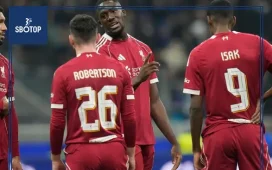The Premier League often thrives on drama, controversies, and fine margins, and the latest clash at Stamford Bridge between Chelsea and Crystal Palace was a perfect illustration. While the match ended in a goalless draw, it was far from uneventful. The spotlight inevitably fell on Eberechi Eze’s disallowed free-kick, chalked off after a VAR intervention citing an unusual law rarely invoked in the modern game.
For Chelsea, the draw extended their inconsistent campaign, highlighting once again their difficulty in breaking down compact defensive setups. For Palace, the point was both a relief and a frustration—proof that they could go toe-to-toe with a bigger club, yet also a reminder of their struggles in capitalizing on key chances.
This article dissects the key talking points: the tactical battle, Chelsea’s recurring problems, Palace’s resilience, and the controversy that dominated headlines.
First Half Chelsea Dominate but Lack Cutting Edge
The game began in familiar fashion for Chelsea at Stamford Bridge. Mauricio Pochettino’s side looked determined to dictate the tempo, pushing their fullbacks high and trying to pin Crystal Palace deep in their defensive third.
Chelsea’s midfield three—anchored by Moisés Caicedo, with Enzo Fernández and Conor Gallagher ahead—controlled possession with ease. Yet, as has been the story for much of their season, possession failed to translate into penetration.
Nicolas Jackson, leading the line, had a half-chance inside the opening 20 minutes when he broke free from Joachim Andersen, but his shot flashed wide of the far post. Raheem Sterling offered width and directness on the left, but his final ball consistently fell short.
Palace, meanwhile, were disciplined. Under Roy Hodgson’s pragmatic guidance, they dropped into two compact banks of four, with Jefferson Lerma and Cheick Doucouré screening the defense. Their plan was clear: frustrate Chelsea, wait for mistakes, and break quickly through Eze and Michael Olise.
Eberechi Eze’s Moment of Magic – Then Controversy
The match truly ignited in the 35th minute. Palace won a free-kick just outside Chelsea’s penalty area after Olise was fouled by Levi Colwill. Up stepped Eberechi Eze, Palace’s talismanic playmaker known for his technical brilliance.
Eze curled a sublime effort over the wall and into the top corner past Robert Sánchez. For a brief moment, the away supporters erupted in celebration, believing their side had seized an unlikely lead.
However, VAR quickly intervened. Replays showed that a Palace player had been standing in an offside position close to Sánchez. While the player made no contact with the ball, officials deemed that his presence obstructed the goalkeeper’s line of sight—triggering Law 11 of the IFAB Laws of the Game, which deals with offside interference.
It was a rarely enforced interpretation of the rule, one that left Palace players, fans, and even neutral observers scratching their heads. The goal was overturned, and the match remained 0-0.
How the Law Was Applied
The disallowed goal hinged on a very specific clause:
“A player in an offside position is considered to be interfering with an opponent if they obstruct the line of vision of the goalkeeper.”
In this case, Palace forward Jean-Philippe Mateta was judged to be in Sánchez’s line of sight. Although the Chelsea keeper had shifted slightly, officials determined that Mateta’s positioning gave him an unfair disadvantage.
The controversy was not about whether the law was applied correctly—it was—but rather whether the interpretation was too pedantic for the spirit of the game. Many pundits argued Sánchez was unlikely to reach the ball regardless, given the speed and accuracy of Eze’s strike.
Nonetheless, the law left little room for flexibility, and Palace were denied what would have been one of the goals of the season.
Chelsea’s Growing Frustrations
If Palace felt aggrieved, Chelsea were not entirely satisfied either. Despite their dominance in possession, they struggled to fashion clear-cut chances.
Mykhailo Mudryk, brought on in the second half to inject pace, found space behind Nathaniel Clyne but often lacked composure. Gallagher came closest with a long-range effort that whistled narrowly wide.
The biggest chance fell to Jackson late in the second half when Sterling squared across the box, but the striker’s scuffed finish summed up Chelsea’s evening.
Fans at Stamford Bridge grew restless, with chants of frustration echoing around the ground. The Blues’ struggles in breaking down low blocks have become a defining flaw under Pochettino, and this match offered little reassurance that the issue is being resolved.
Palace’s Defensive Grit
For Palace, this was a point earned the hard way. Andersen marshaled the backline superbly, winning aerial duels and organizing his defense to withstand wave after wave of Chelsea pressure.
Goalkeeper Sam Johnstone also played a key role, producing sharp saves from Sterling and Fernández. While Palace rarely threatened after the disallowed goal, their defensive discipline was commendable.
Roy Hodgson praised his side’s effort after the game, highlighting their ability to stick to the plan under pressure. Yet he also lamented the decision that denied them what could have been a famous victory at Stamford Bridge.
VAR and the Spirit of the Game
The controversy surrounding Eze’s free-kick once again reignited the debate over VAR’s impact on football. Critics argue that while technology ensures accuracy, it often strips the game of its flow and joy.
Pundit Gary Neville commented post-match:
“That’s the kind of decision that makes fans hate VAR. Technically correct, yes—but nobody in the stadium thought the keeper was saving that. Football should be about moments of brilliance, and that one was robbed from us.”
Chelsea manager Pochettino, while sympathetic, acknowledged that the law was applied as written. Hodgson, by contrast, was visibly frustrated, suggesting that common sense should have prevailed.
The Broader Implications
Beyond the controversy, the result had wider implications for both teams.
- Chelsea’s Top-Four Ambitions: Dropping points at home against mid-table opposition is a blow to their hopes of clawing back into Champions League contention. Unless their attacking efficiency improves, consistency will remain elusive.
- Crystal Palace’s Survival Push: For Palace, every point matters in the battle to secure mid-table safety. While they might feel two points were lost, a draw at Stamford Bridge still strengthens their position relative to relegation rivals.
Tactical Breakdown
-
Chelsea’s Setup
-
-
- Formation: 4-2-3-1
- Strengths: Controlled possession, good territorial dominance, high pressing.
- Weaknesses: Lack of penetration, poor finishing, predictable attacking patterns.
-
-
Palace’s Setup
- Formation: 4-4-2 (defensive shape)
- Strengths: Compact blocks, disciplined midfield screening, set-piece threat.
- Weaknesses: Limited attacking outlet, over-reliance on Eze and Olise for creativity.
Player Ratings
-
Chelsea
-
-
- Robert Sánchez – 6/10: Rarely tested but fortunate with VAR ruling.
- Reece James – 7/10: Energetic, provided width but lacked end product.
- Levi Colwill – 6/10: Solid defensively but rash foul led to disallowed goal.
- Enzo Fernández – 7/10: Controlled tempo but lacked killer pass.
- Raheem Sterling – 6/10: Dangerous runs but wasteful in final third.
- Nicolas Jackson – 5/10: Poor finishing let him down again.
-
-
Crystal Palace
- Sam Johnstone – 8/10: Excellent shot-stopping, key saves.
- Joachim Andersen – 8/10: Commanding at the back, crucial clearances.
- Jefferson Lerma – 7/10: Disciplined shielding, broke up play.
- Eberechi Eze – 8/10: Brilliant free-kick, Palace’s most dangerous player.
- Michael Olise – 6/10: Flashes of creativity but isolated.
- Jean-Philippe Mateta – 5/10: Worked hard but limited influence.
Also Read:
- SBOTOP: Ipswich and Southampton Share the Spoils in 1-1 Portman Road Clash as Promotion Race Heats Up
- SBOTOP: Matheus Cunha and Bryan Mbeumo Hand Man Utd Glimmers of Hope Despite Arsenal Defeat – Premier League Hits and Misses
- SBOTOP James McAtee: Why Manchester City Could Face Regret After Letting Another Academy Gem Go Following Palmer and Rogers Departures








